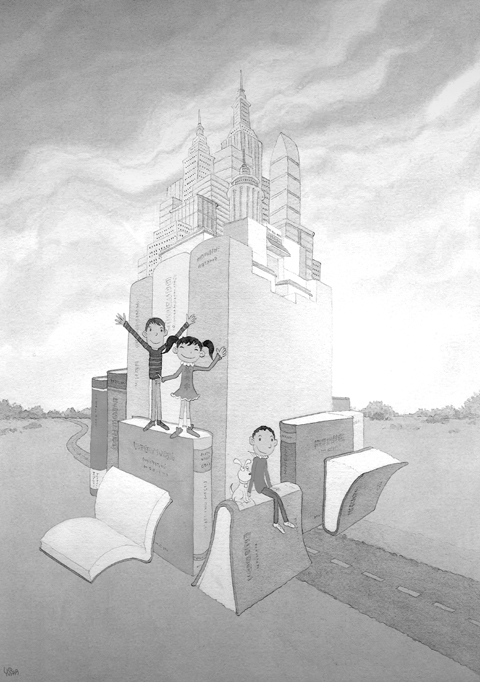It sounds like a student’s dream school — no teachers, no homework, no weekly tests, no grades.
At the Lafayette Big Picture High School students get to design their own learning plan, set their own goals and spend two days a week away from school — bending the ear of a mentor.
But far from a fantasy, the school is designed to better prepare kids on the edge for the real world.

“My friends hear that stuff and think we have it easy here,” 15-year-old freshman Katelin Reusswig said. “I tell them I’ve never worked as hard. It’s just different when you’re learning about something you’re actually interested in and care about.”
This small farming community in upstate New York is one of more than 60 nationwide to experiment with the Big Picture approach over the past decade but among the first rural districts to try it. The schools emphasize work in the real world — internships, portfolios, oral presentations and intense relationships between students, advisers and mentors.
At Lafayette, one instructor — called an adviser instead of a teacher — handles all the lessons and stays with the same class for four years until students graduate. Graduates are expected to apply and be accepted into at least one college, even if they choose not to go.
FINDING A PASSION
“This program is about helping a kid find their passion,” said Leonardo Oppedisano, a former science teacher who is now adviser to the first ninth-grade class.
“I am not a vessel with information trying to impart it all on them. I am advising them on the path that they should take toward learning. It is much more a cooperative relationship,”’ said Oppedisano — “Mr. O” to students.
The Big Picture Co was founded by educators Dennis Littky and Elliot Washor, both formerly of the renowned Thayer High School in New Hampshire and the Annenberg Institute for School Reform at Brown University. In 1996, Littky and Washor opened their first student-centered high school in Providence, Rhode Island, called The Met, which became a national model with its continuing success.
About 7,500 students in 17 states attend Big Picture schools, which boast a 92 percent graduation rate — more than 20 percentage points higher than the New York state and national averages and nearly double the rate for inner city students — and send nearly 95 percent of their students for post-secondary learning, said Damian Ewens, a Big Picture spokesman.
RETAINING STUDENTS
The focus on personalized learning and community involvement is key in retaining students — these approaches tap into what’s relevant and engaging to students, said Elizabeth Schneider, vice president of state relations for the nonprofit Alliance for Excellent Education, which advocates for troubled students.
Nationwide, about 1.2 million students drop out every year. Some studies suggest up to 80 percent of dropouts might have stayed in school and graduated if their schools had provided them with real-world learning opportunities.
“We have to recognize that the old fashioned lecture-style classroom isn’t suited for every student,” Schneider said.
The Lafayette school opened in September with 15 freshmen. Every year, another group will be admitted for a maximum of 60 students.
There is no charge for attending the school, which is staffed with teachers reassigned from the school district and operates from the district’s general budget.
For classrooms, the district converted office space at an elementary school, where the program will have room to grow. Each student gets a computer.
Although anyone can apply, the school is an attempt to attract students who are in danger of dropping out.
“These kids were right on the edge. Most have failed at least one grade and given another year, several would have dropped out,” principal Susan Osborn said.
Ten of the Big Picture students are from the nearby Onondaga Indian Nation, including three of the four freshman girls.
FOCUS ON FUTURE
Katelin Reusswig is an Onondaga. Her three older siblings dropped out of school and she was ready to follow until she heard about the Big Picture school. She wants to run her own day care center.
“I like the idea of getting to shadow someone in the business while I’m getting an education,” she said.
Big Picture students divide their day with time for independent language studies, reading and work on a 45-minute exhibition they are required to give at the end of each 10-week semester. Time is also set aside for community work, writing in their journals and a social reasoning debate.
Next month, students will begin spending two days a week as unpaid apprentices at a job where they were responsible for setting up their own internships.
“There is more individual responsibility here ... but it gives you confidence when you know you can do something for yourself,”’ said 15-year-old Nicole Bishop, who wants to have a career in photography or cosmetology — or maybe both.
To meet state requirements, students must pass five Regents exams before they graduate. This year, they will take the science and math exams, so each day of classes includes time preparing for the year-end tests. Students also have a daily physical education class.
“There’s no homework in the traditional sense ... though there will likely be times they will have to work at home because they were absent, need to meet a deadline or want to get ahead,” Oppedisano said.
TOUGH FINALE
At the end of the semester, students must cover everything they’ve learned through the period and deliver an oral presentation to classmates, parents and an evaluation panel of their choosing.
Current students in the Lafayette program are interested in law enforcement, nursing, photography, music performance and underwater welding.
“I’m definitely more excited about learning now,” Nicole said. “I can see the value to what I’m doing.”

Taiwan has lost Trump. Or so a former State Department official and lobbyist would have us believe. Writing for online outlet Domino Theory in an article titled “How Taiwan lost Trump,” Christian Whiton provides a litany of reasons that the William Lai (賴清德) and Donald Trump administrations have supposedly fallen out — and it’s all Lai’s fault. Although many of Whiton’s claims are misleading or ill-informed, the article is helpfully, if unintentionally, revealing of a key aspect of the MAGA worldview. Whiton complains of the ruling Democratic Progressive Party’s “inability to understand and relate to the New Right in America.” Many
The Centers for Disease Control and Prevention (CDC) earlier this month raised its travel alert for China’s Guangdong Province to Level 2 “Alert,” advising travelers to take enhanced precautions amid a chikungunya outbreak in the region. More than 8,000 cases have been reported in the province since June. Chikungunya is caused by the chikungunya virus and transmitted to humans through bites from infected mosquitoes, most commonly Aedes aegypti and Aedes albopictus. These species thrive in warm, humid climates and are also major vectors for dengue, Zika and yellow fever. The disease is characterized by high fever and severe, often incapacitating joint pain.
In nature, there is a group of insects known as parasitoid wasps. Their reproductive process differs entirely from that of ordinary wasps — the female lays her eggs inside or on the bodies of other insects, and, once hatched, the larvae feed on the host’s body. The larvae do not kill the host insect immediately; instead, they carefully avoid vital organs, allowing the host to stay alive until the larvae are fully mature. That living reservoir strategy ensures a stable and fresh source of nutrients for the larvae as they grow. However, the host’s death becomes only a matter of time. The resemblance
Most countries are commemorating the 80th anniversary of the end of World War II with condemnations of militarism and imperialism, and commemoration of the global catastrophe wrought by the war. On the other hand, China is to hold a military parade. According to China’s state-run Xinhua news agency, Beijing is conducting the military parade in Tiananmen Square on Sept. 3 to “mark the 80th anniversary of the end of World War II and the victory of the Chinese People’s War of Resistance Against Japanese Aggression.” However, during World War II, the People’s Republic of China (PRC) had not yet been established. It